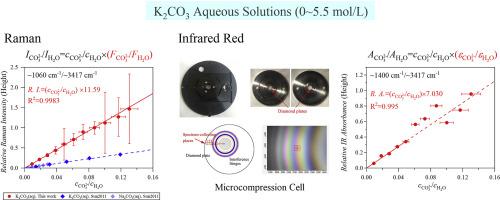Geoscience Frontiers ( IF 8.5 ) Pub Date : 2020-03-13 , DOI: 10.1016/j.gsf.2020.03.002 Yunlu Ma , Wei Yan , Qiang Sun , Xi Liu

|
Carbonate-bearing fluids widely exist in different geological settings, and play important roles in transporting some elements such as the rare earth elements. They may be trapped as large or small fluid inclusions (with the size down to <1 μm sometimes), and record critical physical-chemical signals for the formations of their host minerals. Spectroscopic methods like Raman spectroscopy and infrared spectroscopy have been proposed as effective methods to quantify the carbonate concentrations of these fluid inclusions. Although they have some great technical advantages over the conventional microthermometry method, there are still some technical difficulties to overcome before they can be routinely used to solve relevant geological problems. The typical limitations include their interlaboratory difference and poor performance on micro fluid inclusions. This study prepared standard ion-distilled water and K2CO3 aqueous solutions at different molarities (from 0.5 to 5.5 mol/L), measured densities, collected Raman and infrared spectra, and explored correlations between the K2CO3 molarity and the spectroscopic features at ambient P-T conditions. The result confirms that the Raman O–H stretching mode can be used as an internal standard to determine the carbonate concentrations despite some significant differences among the correlations, established in different laboratories, between the relative Raman intensity of the C–O symmetric stretching mode and that of the O–H stretching mode. It further reveals that the interlaboratory difference can be readily removed by performing one high-quality calibration experiment, provided that later quantifying analyses are conducted using the same Raman spectrometer with the same analytical conditions. Our infrared absorption data were collected from thin fluid films (thickness less than ~2 μm) formed by pressing the prepared solutions in a Microcompression Cell with two diamond-II plates. The data show that both the O–H stretching mode and the O–H bending mode can be used as internal standards to determine the carbonate concentrations. Since the IR signals of the C–O antisymmetric stretching vibration of the CO32− ion, and the O–H stretching and bending vibrations from our thin films are very strong, their relative IR absorbance intensity, if well calibrated, can be used to investigate the micron-sized carbonate-bearing aqueous fluid inclusions. This study establishes the first calibration of this kind, which may have some applications. Additionally, our spectroscopic data suggest that as the K2CO3 concentration increases the aqueous solution forms more large water molecule clusters via more intense hydrogen-bonding. This process may significantly alter the physical and chemical behavior of the fluids.
中文翻译:

以水为内标的拉曼光谱和红外光谱定量分析K 2 CO 3水溶液中的碳酸盐浓度
含碳酸盐的流体广泛存在于不同的地质环境中,并在运输某些元素(例如稀土元素)中发挥重要作用。它们可能被捕获为大或小的流体包裹体(有时尺寸小于1μm),并记录有关其宿主矿物形成的关键物理化学信号。已经提出了诸如拉曼光谱和红外光谱的光谱方法作为量化这些流体夹杂物的碳酸盐浓度的有效方法。尽管它们比常规的微热法具有一些巨大的技术优势,但是在常规使用它们来解决相关的地质问题之前,仍然需要克服一些技术难题。典型的局限性包括实验室之间的差异以及微流体夹杂物的性能差。本研究制备了标准的离子蒸馏水和K在不同摩尔浓度(0.5至5.5 mol / L)下测量2种CO 3水溶液,测量密度,收集拉曼光谱和红外光谱,并探索在环境P - T下K 2 CO 3摩尔浓度与光谱特征之间的相关性条件。结果证实,尽管在不同实验室建立的C–O对称拉伸模式的相对拉曼强度与相对强度之间的相关性之间存在一些显着差异,但拉曼O–H拉伸模式可以用作测定碳酸盐浓度的内标。 O–H拉伸模式。它进一步揭示,只要使用相同的拉曼光谱仪在相同的分析条件下进行后续的定量分析,即可通过执行一项高质量的校准实验轻松消除实验室间的差异。我们的红外吸收数据是从在两块Diamond-II板的微型压缩室中压制制备的溶液而形成的薄流体膜(厚度小于2μm)中收集的。数据显示,O–H拉伸模式和O–H弯曲模式都可以用作确定碳酸盐浓度的内标。由于红外的CO反对称拉伸信号使CO振动3 2-离子以及我们薄膜的O–H拉伸和弯曲振动非常强,如果对其进行了很好的校准,它们的相对IR吸收强度可用于研究微米级的含碳酸盐的含水流体包裹体。这项研究建立了这种第一个校准方法,它可能有一些应用。此外,我们的光谱数据表明,随着K 2 CO 3浓度的增加,水溶液会通过更强烈的氢键作用而形成更大的水分子簇。该过程可能会显着改变流体的物理和化学行为。






























 京公网安备 11010802027423号
京公网安备 11010802027423号